Mental Health Forum Discussion: Impact of Trauma on Professionals
VerifiedAdded on 2023/06/06
|6
|1186
|329
Discussion Board Post
AI Summary
This discussion board post examines vicarious trauma, also known as secondary trauma, and its effects on mental health professionals. It begins by defining vicarious trauma and outlining its symptoms, which are categorized into emotional, behavioral, psychological, and cognitive domains. The post then addresses self-care strategies for professionals, including both personal and organizational barriers to self-care, and emphasizes the importance of activities like journaling, taking breaks, and maintaining a work-life balance. Furthermore, it explores proactive strategies such as awareness, balance, and connection to mitigate the impact of vicarious trauma. Finally, the post suggests policies that community services and health organizations can implement to support workers, such as encouraging breaks, promoting self-care discussions, and establishing self-care groups. The post references The BlueKnot Foundation and provides a list of references to support its claims.
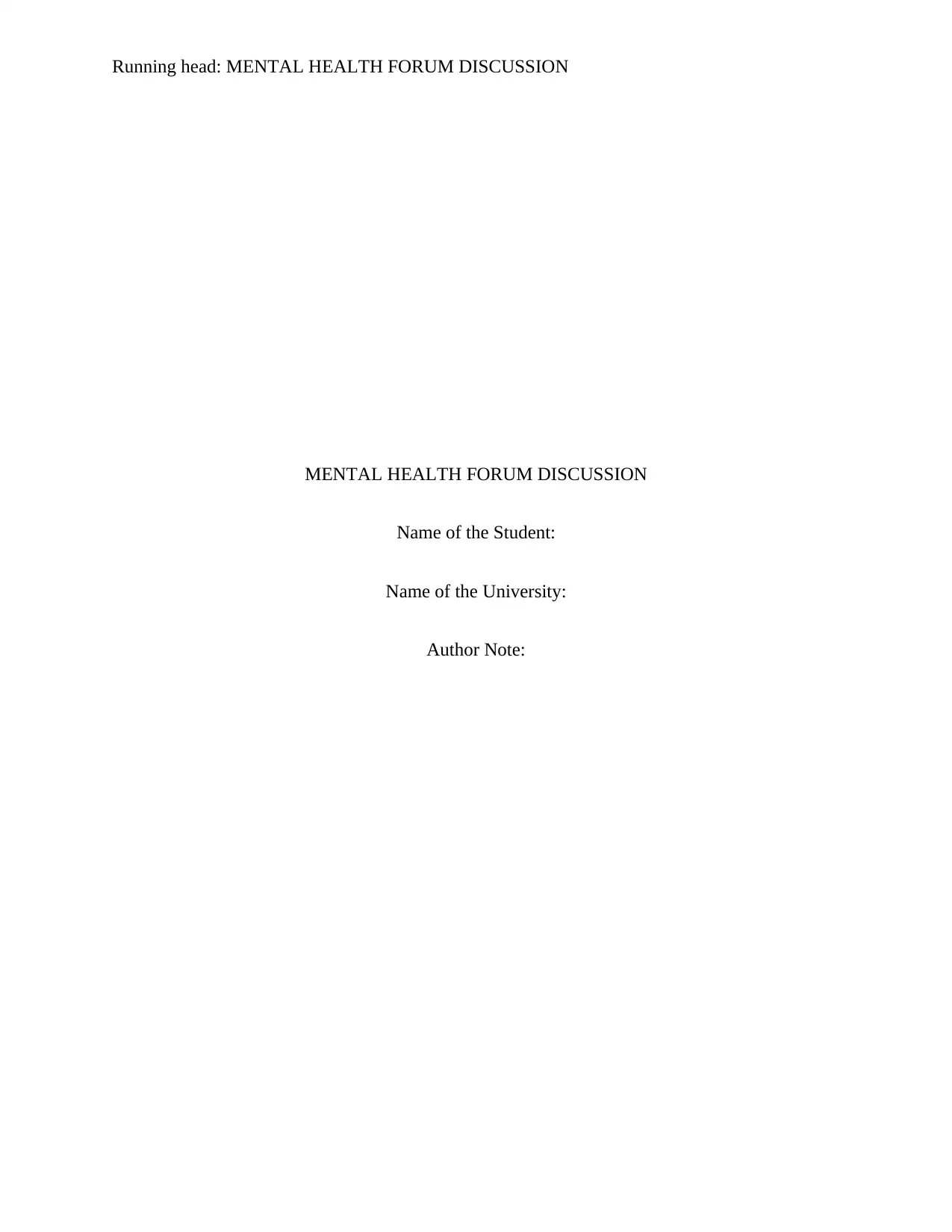
Running head: MENTAL HEALTH FORUM DISCUSSION
MENTAL HEALTH FORUM DISCUSSION
Name of the Student:
Name of the University:
Author Note:
MENTAL HEALTH FORUM DISCUSSION
Name of the Student:
Name of the University:
Author Note:
Paraphrase This Document
Need a fresh take? Get an instant paraphrase of this document with our AI Paraphraser
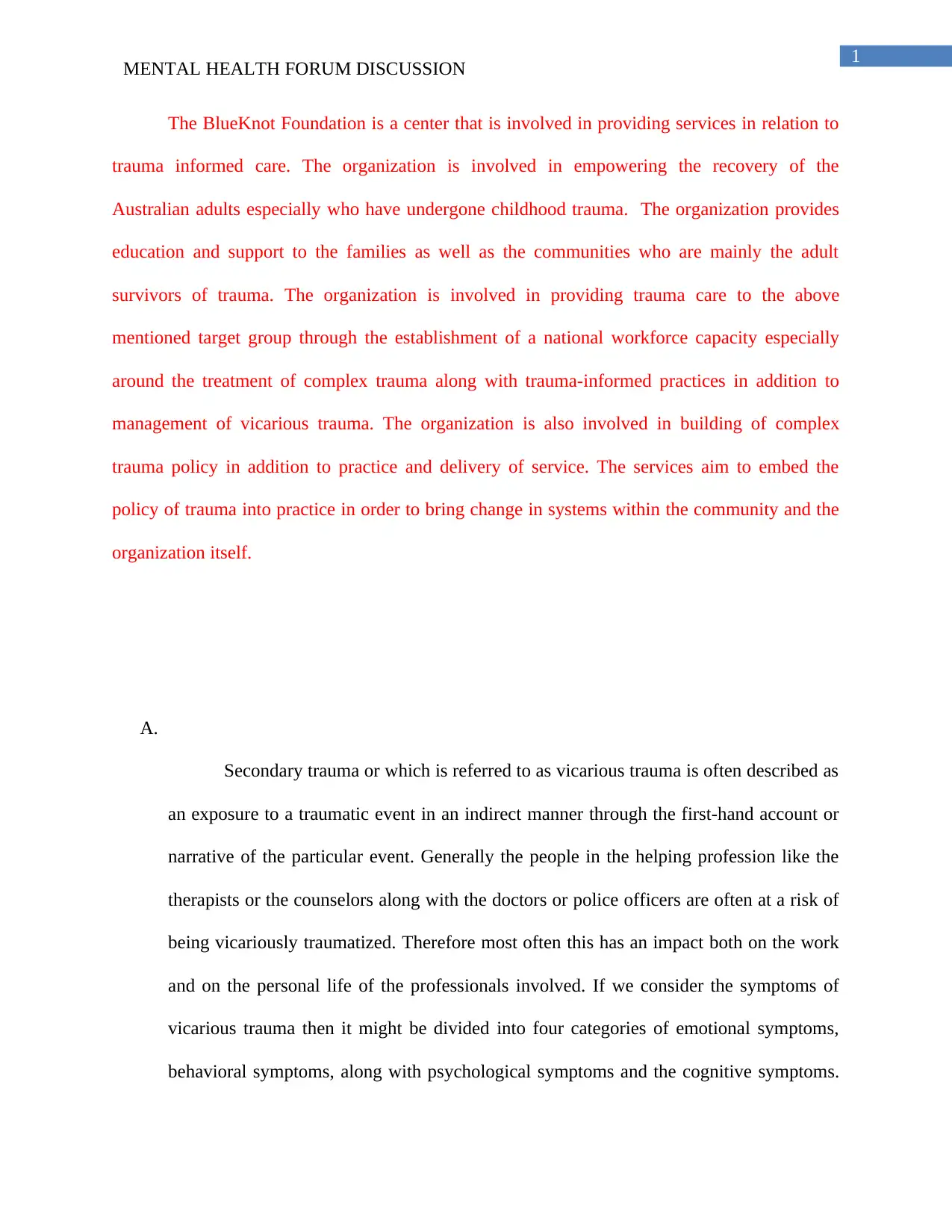
MENTAL HEALTH FORUM DISCUSSION 1
The BlueKnot Foundation is a center that is involved in providing services in relation to
trauma informed care. The organization is involved in empowering the recovery of the
Australian adults especially who have undergone childhood trauma. The organization provides
education and support to the families as well as the communities who are mainly the adult
survivors of trauma. The organization is involved in providing trauma care to the above
mentioned target group through the establishment of a national workforce capacity especially
around the treatment of complex trauma along with trauma-informed practices in addition to
management of vicarious trauma. The organization is also involved in building of complex
trauma policy in addition to practice and delivery of service. The services aim to embed the
policy of trauma into practice in order to bring change in systems within the community and the
organization itself.
A.
Secondary trauma or which is referred to as vicarious trauma is often described as
an exposure to a traumatic event in an indirect manner through the first-hand account or
narrative of the particular event. Generally the people in the helping profession like the
therapists or the counselors along with the doctors or police officers are often at a risk of
being vicariously traumatized. Therefore most often this has an impact both on the work
and on the personal life of the professionals involved. If we consider the symptoms of
vicarious trauma then it might be divided into four categories of emotional symptoms,
behavioral symptoms, along with psychological symptoms and the cognitive symptoms.
The BlueKnot Foundation is a center that is involved in providing services in relation to
trauma informed care. The organization is involved in empowering the recovery of the
Australian adults especially who have undergone childhood trauma. The organization provides
education and support to the families as well as the communities who are mainly the adult
survivors of trauma. The organization is involved in providing trauma care to the above
mentioned target group through the establishment of a national workforce capacity especially
around the treatment of complex trauma along with trauma-informed practices in addition to
management of vicarious trauma. The organization is also involved in building of complex
trauma policy in addition to practice and delivery of service. The services aim to embed the
policy of trauma into practice in order to bring change in systems within the community and the
organization itself.
A.
Secondary trauma or which is referred to as vicarious trauma is often described as
an exposure to a traumatic event in an indirect manner through the first-hand account or
narrative of the particular event. Generally the people in the helping profession like the
therapists or the counselors along with the doctors or police officers are often at a risk of
being vicariously traumatized. Therefore most often this has an impact both on the work
and on the personal life of the professionals involved. If we consider the symptoms of
vicarious trauma then it might be divided into four categories of emotional symptoms,
behavioral symptoms, along with psychological symptoms and the cognitive symptoms.
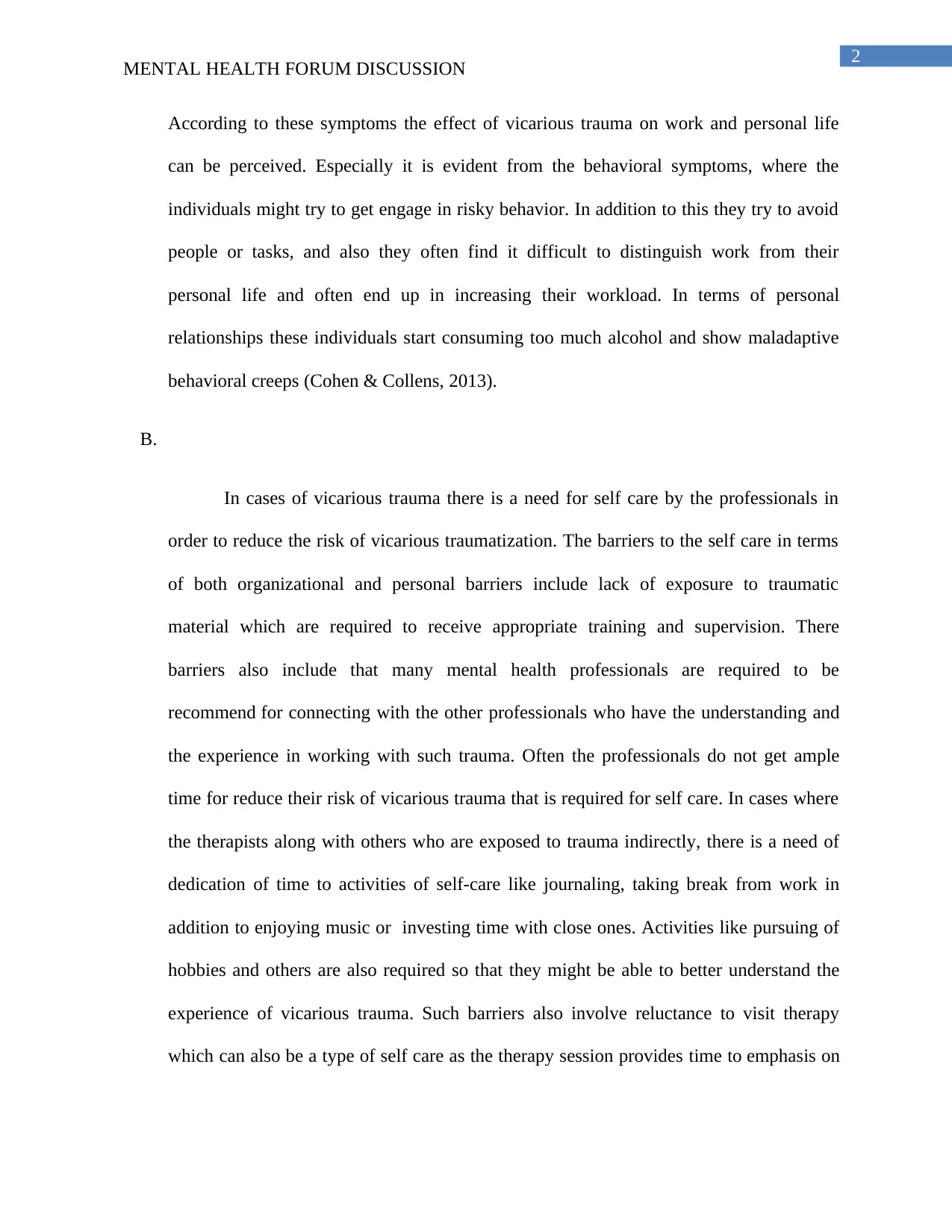
2
MENTAL HEALTH FORUM DISCUSSION
According to these symptoms the effect of vicarious trauma on work and personal life
can be perceived. Especially it is evident from the behavioral symptoms, where the
individuals might try to get engage in risky behavior. In addition to this they try to avoid
people or tasks, and also they often find it difficult to distinguish work from their
personal life and often end up in increasing their workload. In terms of personal
relationships these individuals start consuming too much alcohol and show maladaptive
behavioral creeps (Cohen & Collens, 2013).
B.
In cases of vicarious trauma there is a need for self care by the professionals in
order to reduce the risk of vicarious traumatization. The barriers to the self care in terms
of both organizational and personal barriers include lack of exposure to traumatic
material which are required to receive appropriate training and supervision. There
barriers also include that many mental health professionals are required to be
recommend for connecting with the other professionals who have the understanding and
the experience in working with such trauma. Often the professionals do not get ample
time for reduce their risk of vicarious trauma that is required for self care. In cases where
the therapists along with others who are exposed to trauma indirectly, there is a need of
dedication of time to activities of self-care like journaling, taking break from work in
addition to enjoying music or investing time with close ones. Activities like pursuing of
hobbies and others are also required so that they might be able to better understand the
experience of vicarious trauma. Such barriers also involve reluctance to visit therapy
which can also be a type of self care as the therapy session provides time to emphasis on
MENTAL HEALTH FORUM DISCUSSION
According to these symptoms the effect of vicarious trauma on work and personal life
can be perceived. Especially it is evident from the behavioral symptoms, where the
individuals might try to get engage in risky behavior. In addition to this they try to avoid
people or tasks, and also they often find it difficult to distinguish work from their
personal life and often end up in increasing their workload. In terms of personal
relationships these individuals start consuming too much alcohol and show maladaptive
behavioral creeps (Cohen & Collens, 2013).
B.
In cases of vicarious trauma there is a need for self care by the professionals in
order to reduce the risk of vicarious traumatization. The barriers to the self care in terms
of both organizational and personal barriers include lack of exposure to traumatic
material which are required to receive appropriate training and supervision. There
barriers also include that many mental health professionals are required to be
recommend for connecting with the other professionals who have the understanding and
the experience in working with such trauma. Often the professionals do not get ample
time for reduce their risk of vicarious trauma that is required for self care. In cases where
the therapists along with others who are exposed to trauma indirectly, there is a need of
dedication of time to activities of self-care like journaling, taking break from work in
addition to enjoying music or investing time with close ones. Activities like pursuing of
hobbies and others are also required so that they might be able to better understand the
experience of vicarious trauma. Such barriers also involve reluctance to visit therapy
which can also be a type of self care as the therapy session provides time to emphasis on
⊘ This is a preview!⊘
Do you want full access?
Subscribe today to unlock all pages.

Trusted by 1+ million students worldwide
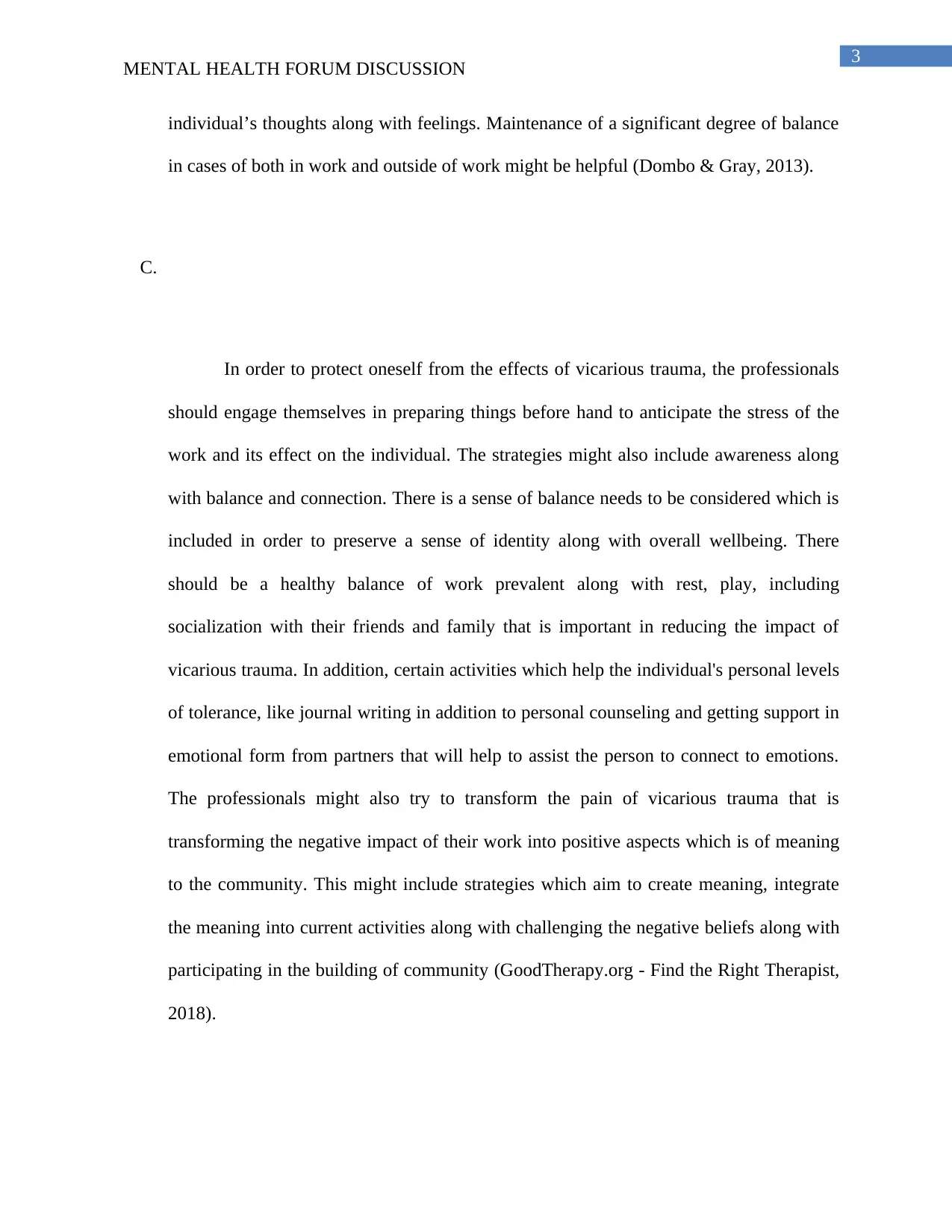
3
MENTAL HEALTH FORUM DISCUSSION
individual’s thoughts along with feelings. Maintenance of a significant degree of balance
in cases of both in work and outside of work might be helpful (Dombo & Gray, 2013).
C.
In order to protect oneself from the effects of vicarious trauma, the professionals
should engage themselves in preparing things before hand to anticipate the stress of the
work and its effect on the individual. The strategies might also include awareness along
with balance and connection. There is a sense of balance needs to be considered which is
included in order to preserve a sense of identity along with overall wellbeing. There
should be a healthy balance of work prevalent along with rest, play, including
socialization with their friends and family that is important in reducing the impact of
vicarious trauma. In addition, certain activities which help the individual's personal levels
of tolerance, like journal writing in addition to personal counseling and getting support in
emotional form from partners that will help to assist the person to connect to emotions.
The professionals might also try to transform the pain of vicarious trauma that is
transforming the negative impact of their work into positive aspects which is of meaning
to the community. This might include strategies which aim to create meaning, integrate
the meaning into current activities along with challenging the negative beliefs along with
participating in the building of community (GoodTherapy.org - Find the Right Therapist,
2018).
MENTAL HEALTH FORUM DISCUSSION
individual’s thoughts along with feelings. Maintenance of a significant degree of balance
in cases of both in work and outside of work might be helpful (Dombo & Gray, 2013).
C.
In order to protect oneself from the effects of vicarious trauma, the professionals
should engage themselves in preparing things before hand to anticipate the stress of the
work and its effect on the individual. The strategies might also include awareness along
with balance and connection. There is a sense of balance needs to be considered which is
included in order to preserve a sense of identity along with overall wellbeing. There
should be a healthy balance of work prevalent along with rest, play, including
socialization with their friends and family that is important in reducing the impact of
vicarious trauma. In addition, certain activities which help the individual's personal levels
of tolerance, like journal writing in addition to personal counseling and getting support in
emotional form from partners that will help to assist the person to connect to emotions.
The professionals might also try to transform the pain of vicarious trauma that is
transforming the negative impact of their work into positive aspects which is of meaning
to the community. This might include strategies which aim to create meaning, integrate
the meaning into current activities along with challenging the negative beliefs along with
participating in the building of community (GoodTherapy.org - Find the Right Therapist,
2018).
Paraphrase This Document
Need a fresh take? Get an instant paraphrase of this document with our AI Paraphraser
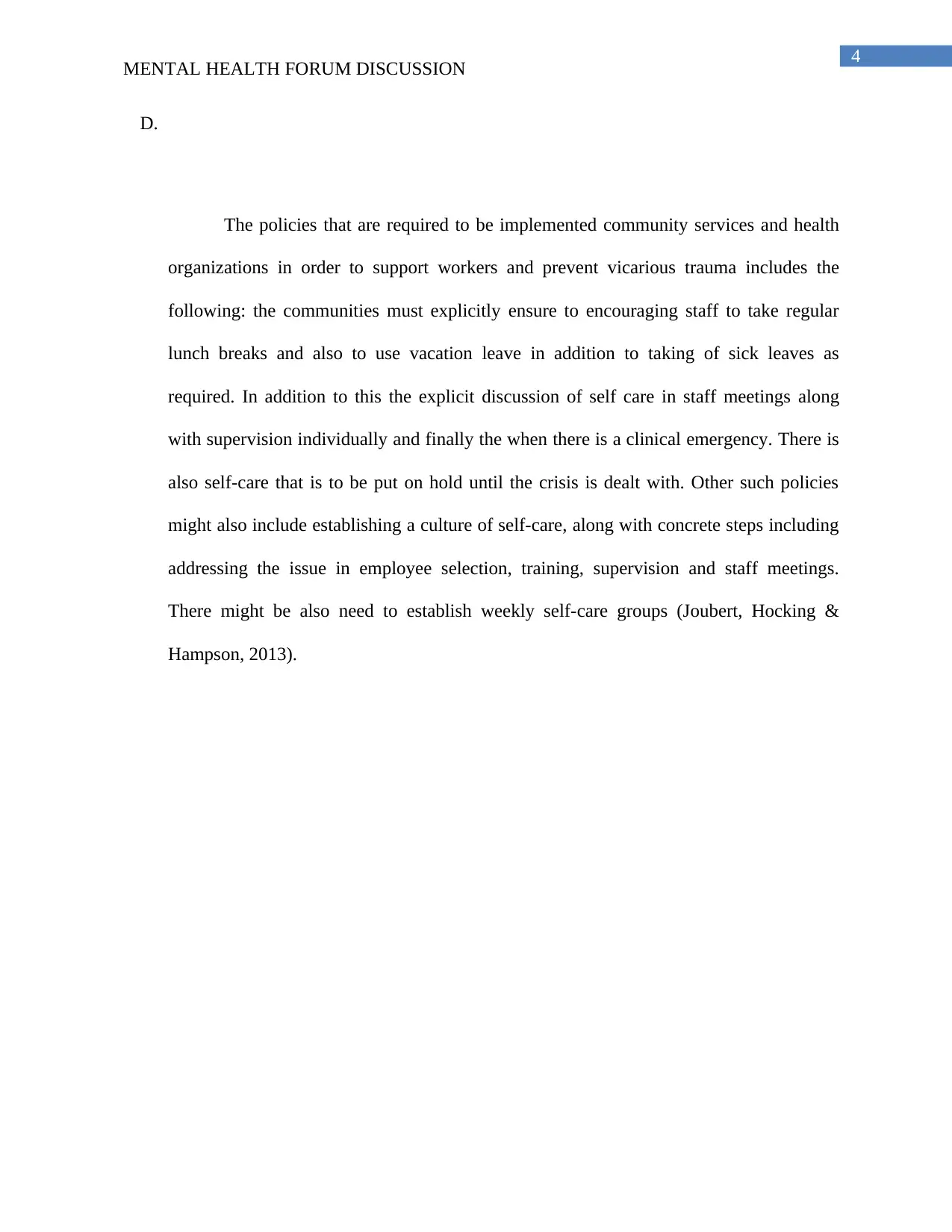
4
MENTAL HEALTH FORUM DISCUSSION
D.
The policies that are required to be implemented community services and health
organizations in order to support workers and prevent vicarious trauma includes the
following: the communities must explicitly ensure to encouraging staff to take regular
lunch breaks and also to use vacation leave in addition to taking of sick leaves as
required. In addition to this the explicit discussion of self care in staff meetings along
with supervision individually and finally the when there is a clinical emergency. There is
also self-care that is to be put on hold until the crisis is dealt with. Other such policies
might also include establishing a culture of self-care, along with concrete steps including
addressing the issue in employee selection, training, supervision and staff meetings.
There might be also need to establish weekly self-care groups (Joubert, Hocking &
Hampson, 2013).
MENTAL HEALTH FORUM DISCUSSION
D.
The policies that are required to be implemented community services and health
organizations in order to support workers and prevent vicarious trauma includes the
following: the communities must explicitly ensure to encouraging staff to take regular
lunch breaks and also to use vacation leave in addition to taking of sick leaves as
required. In addition to this the explicit discussion of self care in staff meetings along
with supervision individually and finally the when there is a clinical emergency. There is
also self-care that is to be put on hold until the crisis is dealt with. Other such policies
might also include establishing a culture of self-care, along with concrete steps including
addressing the issue in employee selection, training, supervision and staff meetings.
There might be also need to establish weekly self-care groups (Joubert, Hocking &
Hampson, 2013).
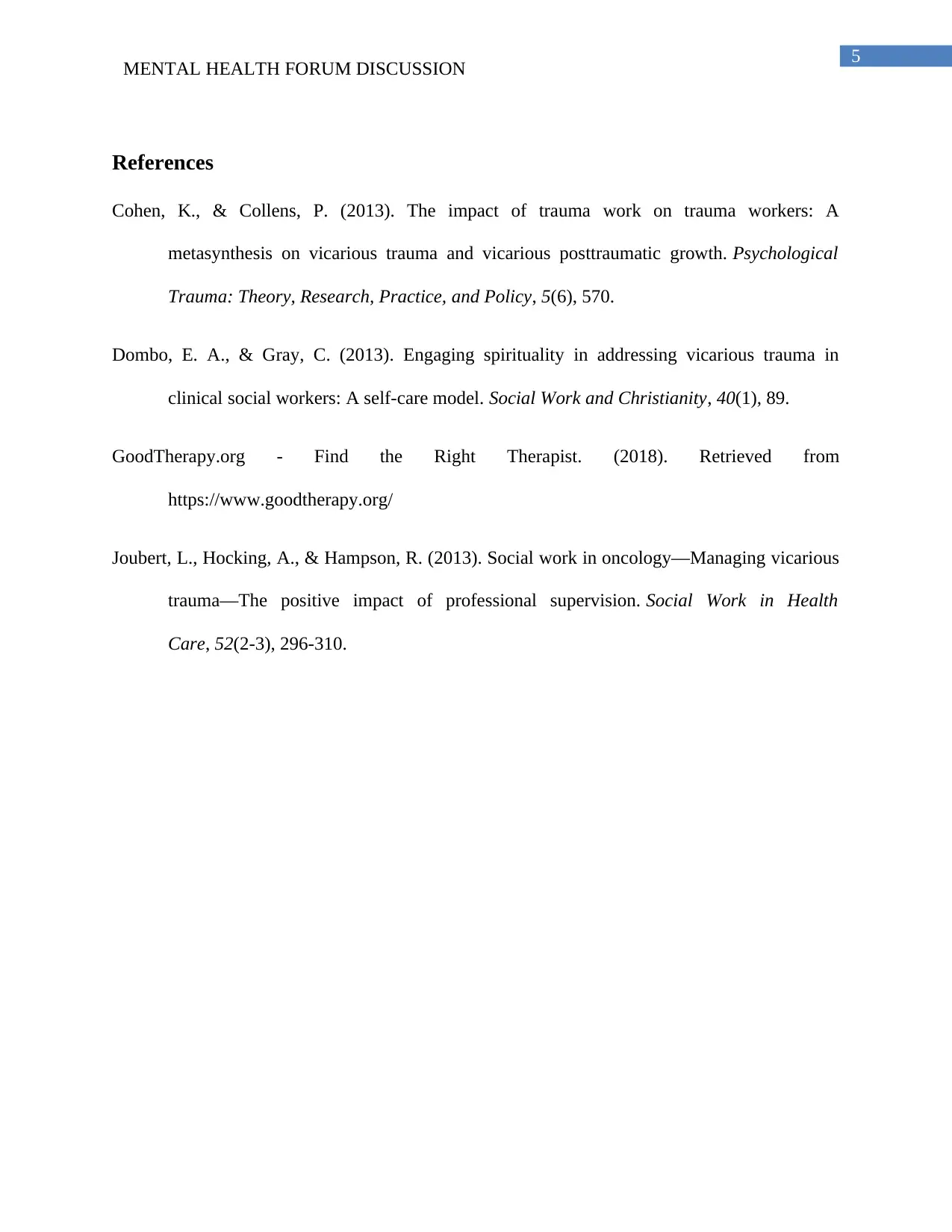
5
MENTAL HEALTH FORUM DISCUSSION
References
Cohen, K., & Collens, P. (2013). The impact of trauma work on trauma workers: A
metasynthesis on vicarious trauma and vicarious posttraumatic growth. Psychological
Trauma: Theory, Research, Practice, and Policy, 5(6), 570.
Dombo, E. A., & Gray, C. (2013). Engaging spirituality in addressing vicarious trauma in
clinical social workers: A self-care model. Social Work and Christianity, 40(1), 89.
GoodTherapy.org - Find the Right Therapist. (2018). Retrieved from
https://www.goodtherapy.org/
Joubert, L., Hocking, A., & Hampson, R. (2013). Social work in oncology—Managing vicarious
trauma—The positive impact of professional supervision. Social Work in Health
Care, 52(2-3), 296-310.
MENTAL HEALTH FORUM DISCUSSION
References
Cohen, K., & Collens, P. (2013). The impact of trauma work on trauma workers: A
metasynthesis on vicarious trauma and vicarious posttraumatic growth. Psychological
Trauma: Theory, Research, Practice, and Policy, 5(6), 570.
Dombo, E. A., & Gray, C. (2013). Engaging spirituality in addressing vicarious trauma in
clinical social workers: A self-care model. Social Work and Christianity, 40(1), 89.
GoodTherapy.org - Find the Right Therapist. (2018). Retrieved from
https://www.goodtherapy.org/
Joubert, L., Hocking, A., & Hampson, R. (2013). Social work in oncology—Managing vicarious
trauma—The positive impact of professional supervision. Social Work in Health
Care, 52(2-3), 296-310.
⊘ This is a preview!⊘
Do you want full access?
Subscribe today to unlock all pages.

Trusted by 1+ million students worldwide
1 out of 6
Related Documents
Your All-in-One AI-Powered Toolkit for Academic Success.
+13062052269
info@desklib.com
Available 24*7 on WhatsApp / Email
![[object Object]](/_next/static/media/star-bottom.7253800d.svg)
Unlock your academic potential
Copyright © 2020–2025 A2Z Services. All Rights Reserved. Developed and managed by ZUCOL.



